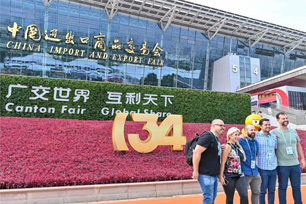Skilled trader sets gold standard
The future is shining bright for Hong Kong's one and only certified physical bullion trade platform, thanks to mainland routes. Chai Hua reports.
The Chinese Gold and Silver Exchange Society (CGSE), a 106-year-old bullion platform and the only one in Hong Kong authorized to trade in physical gold and silver, is exploring new business opportunities across the border on the Chinese mainland.
Founded in 1910, the CGSE is the only gold and silver exchange recognized by the Hong Kong government and one of the world's top five gold trading platforms.
"There is no doubt that the international center of gold trade will transfer from Western to Eastern countries in the near future," Haywood Cheung Tak-hay, the honorary permanent president of the CGSE, told China Daily in an exclusive interview in Hong Kong.
Golden glow
The Chinese mainland is currently the largest producer and buyer of gold worldwide, with total production and imports accounting for 60 percent of the global total in 2015.
Major Asian exchanges have been striving in recent years to become new gold trading centers. Among these are the Shanghai Gold Exchange, which last month launched a yuan-denominated gold benchmark, and local bourse operator Hong Kong Exchanges and Clearing Ltd, which has revealed plans to launch gold futures products.
The CGSE last July launched the "Shanghai-Hong Kong Gold Connect", allowing the exchange legal access to the mainland market through 15 State-approved banks with gold import licenses.
But it is Shenzhen, the next-door neighbor of Hong Kong, that holds the most promise in this sector, believes Cheung, given the showpiece Guangdong city's more than 30 years of experience in metal trading, securities and futures brokerage and forex dealing.
"Though trading platforms are in Hong Kong and Shanghai, the customers are in Shenzhen," he explained. "Its demand has decided its position as the center of the Asian and even global gold and jewelry industry." Shenzhen is the country's largest processing base and trading center for gold and jewelry production, providing for 70 percent of the mainland market.
Led by such confidence in Shenzhen's potential, Cheung, as chairman of the Shenzhen Qianhai Chinese Gold & Silver Exchange Society Ltd, led 68 of the CGSE's 171 local and international members to register in the Qianhai special economic zone in 2014.
Hong Kong's CGSE is establishing a 1,500-ton capacity gold vault in Shenzhen in order to connect inland mining enterprises and Shenzhen's processors with international industry participants.
The facility, which is expected to be one of the world's largest permanent gold vaults, is located in a bonded port in the Qianhai special economic zone, itself part of the Guangdong Free-Trade Zone (FTZ).
Cheung revealed that the CGSE will invest at least HK$2 billion to build the facility, which also includes 100,000 square meters of office and trading area.
But the warehouse will take two years to build and, meanwhile, the CGSE has teamed up with the Industrial and Commercial Bank of China to open a temporary bonded warehouse this September for current business.
The Hong Kong government currently has one warehouse at Chek Lap Kok airport, built upon the request of CGSE in 2005, but its 100-ton storage volume is "far from enough", Cheung said.
Mainland jewelry traders and manufacturers usually buy gold from Hong Kong, mostly through the CGSE, but that imported gold then has to be transported to their factories in Shenzhen.
Cheung believes that having the warehouse in Shenzhen can cut their transportation and insurance costs by 10 to 15 percent. Moreover, tax incentives in the Qianhai special zone can attract many international and mainland gold traders.
In addition, the warehouse not only serves CGSE members, but is also open to other gold exchanges, Cheung added.
For instance, it can provide physical delivery support for bonded futures products, which the Hong Kong stock exchange is developing.
Cheung believes the warehouse has an important role to play in the internationalization of the mainland gold market and would help the country gain greater pricing power in the global market.
Checkpoint Qianhai
Cheung is "extremely excited" to be able to bring the CGSE's business to Qianhai. "The FTZ in Guangdong is a golden chance for Hong Kong enterprises to take off," he said.
He pointed out that the SAR has had only one such opportunity so far, and that was 35 years ago, when the Shenzhen special zone was established as the pilot area for the country's reform and opening up drive.
"At the time, many Hong Kong people went up to Shenzhen to set up medium- and small-sized factories making toys, clothes and other goods, and they indeed earned a fortune," Cheung said.
But with Shenzhen moving its manufacturing industry to inland cities and amid surging costs of local land and manpower, the situation has changed, he believes.
What is worse, Cheung is worried that the Hong Kong economy is becoming stagnant and threatened by Singapore, Shanghai, and even Shenzhen. His method of reducing such threats is to cooperate with these rivals, as Hong Kong needs more economic partners.
He regards the relationship between Shanghai and Hong Kong as the negative and positive poles of the same magnet, which can attract more traders if the pair works together.
"And Shenzhen is in the middle of the magnet, so we must go into Guangdong FTZ."
He refers to the opening of free-trade zones, especially the Qianhai area in Shenzhen, as a second wind for Hong Kong's further rise as a financial center.
The Qianhai Shenzhen-Hong Kong Modern Service Industry Cooperation Zone was established in 2010 and last year included in the China (Guangdong) Pilot FTZ, which also covers Zhuhai's Hengqin and Guangzhou's Nansha districts.
As of April 15, more than 90,000 companies were registered in Qianhai, but only 3,142 of those were from Hong Kong.
Cheung reminded Hong Kong enterprises, especially medium- and small-sized companies, to look ahead into avenues for future benefits and seize the opportunity as soon as possible.
As for exploring mainland business, he shows a similar zeal. "As soon as I learned about the Qianhai special zone four years ago, I tried to connect with its management bureau and seek cooperation," Cheung recalled.
However, he also urged the authority for more "bold" policies in the zone: "For example, we need 22 hours of customs clearance for the gold warehouse so that our users can operate in the evening."
Contact the writer at grace@chinadailyhk.com
(HK Edition 05/23/2016 page9)



 Print
Print Mail
Mail

